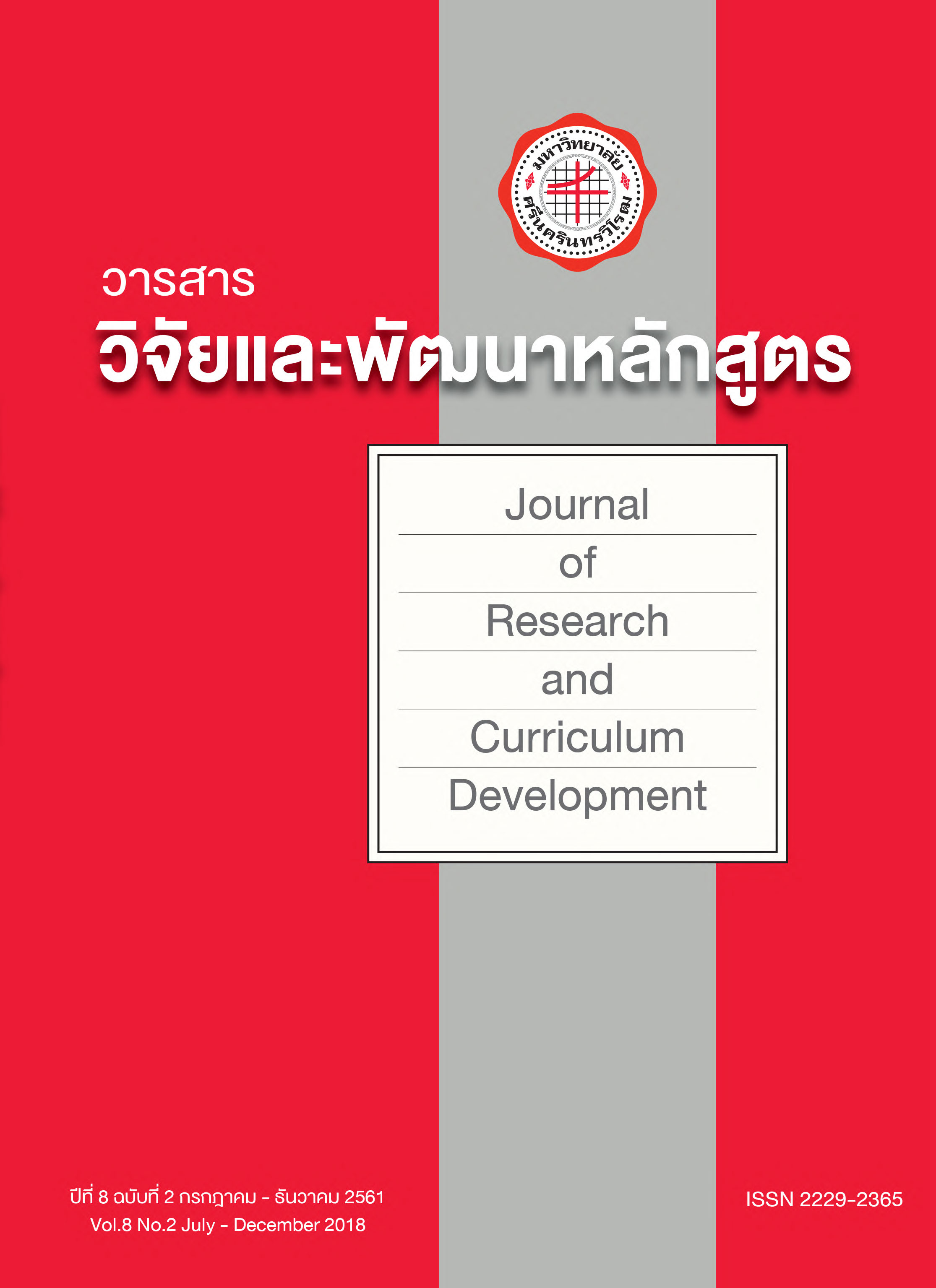การบูรณาเนื้อหาสุขศึกษากับการใช้ภาษาอังกฤษและเทคโนโลยีเป็นสื่อในการจัดการเรียนรู้
Keywords:
Learning management, Content integrated, English, Technology, Medium of LearningAbstract
Developing health behaviors throughout health education with modern process will be one of the best tools of improving the quality of life to be better and sustainable. This paper aims to explain the purpose of a concept in learning management for Health Education by Integrated Content, English Language, and Technology as a medium of learning. This article is composed of the significance of the concept, relevance of concepts and theories, and guidelines of the learning management. This approach would be able to develop the learners in health behaviors and sustainable autonomous learning skills. As a result, the social context has been affected human life by using the communication through online social network; this approach will be the preparation of our human resources in developing Thai economic and social mechanical into the stage of globalization. Thus, this way can assist our learners to meet requirements in updating of the content in health education and enhancing the effective and sustainable leaning process.
References
กระทรวงสาธารณสุข. (2017). สรุป Thailand 4.0. ด้านสาธารณสุข. [ออนไลน์]. แหล่งที่มา: https://ict.moph.go.th/upload_file/files/. [24 มีนาคม 2561]
จักษณา อธิรัตน์ปัญญา. (2558). วิเคราะห์องค์ประกอบของคุณครูดีในระดับการศึกษาขั้นพื้นฐาน. วารสารวิจัยและพัฒนาหลักสูตร. 6 (2) หน้า 1-13.
จุฬารัตน์ ธรรมประทีป (2559). การพัฒนาความรู้ในเนื้อหาผนวกวิธีสอนและเทคโนโลยีในการสอนวิทยาศาสตร์. วารสารวิจัยและพัฒนาหลักสูตร. 6(2) หน้า 30-48.
วรรษา เปาอินทร์ (2560). Thailand Health 4.0 challenges and opportunities. Journal of the Thai Medical Informatics Association, 1, 31-36.
สำนักความสัมพันธ์ต่างประเทศ. (2555). โครงการ Spirit of ASEAN. กระทรวงศึกษาธิการ [ออนไลน์]. แหล่งที่มา: https://www.bic.moe.go.th/index.php?id=31&L. [4 พฤษภาคม 2557]
สำนักงานกองทุนสนับสนุนการสร้างเสริมสุขภา. (2561). รายงานสุขภาพคนไทย. [ออนไลน์]. แหล่งที่มา: https://www.thaihealth.or.th/Content/33499-%E0%B8%82%E0%B8%B1%E0%B8%9A%E0%B9%80%E0%B8%84%E0%B8%A5%E0%B8%B7%E0%B9%88%E0%B8%AD%E0%B8%99%E0%B8%81%E0%B8%B2%E0%B8%A3%E0%B8%A8%E0%B8%B6%E0%B8%81%E0%B8%A9%E0%B8%B2%E0%B9%84%E0%B8%97%E0%B8%A2%E0%B8%AA%E0%B8%B9%E0%B9%88%20%E0%B9%84%E0%B8%97%E0%B8%A2%E0%B9%81%E0%B8%A5%E0%B8%99%E0%B8%94%E0%B9%8C%204.0.html. [21 มีนาคม 2561]
สำนักบริหารงานมัธยมศึกษาตอนปลาย กระทรวงศึกษาธิการ. (2561). สถาบันคุรุพัฒนาเตรียมหลักสูตรพัฒนาครูปี 61 อย่างเข้มข้น เน้นคุณภาพ ทันต่อโลกศตวรรษที่ 21. ศธ.เตรียมหลักสูตรพัฒนาครูปี 2561. [ออนไลน์]. แหล่งที่มา: https://webs.rmutl.ac.th/assets/upload/files. [16 มีนาคม 2561]
สถาบันวิจัยประชากรและสังคมมหาวิทยาลัยมหิดล. (2557). สุขภาพคนไทย. กรุงเทพ: บริษัท อมรินทร์พริ้นติ้งแอนด์พับลิชชิ่ง จำกัด (มหาชน).
สำนักงานพัฒนาธุรกรรมทางอิเล็กทรอนิกส์ (2017) . รายงานผลการสำรวจพฤติกรรมผู้ใช้อินเทอร์เน็ตในประเทศไทย ปี 2560. [ออนไลน์]. แหล่งที่มา: https://www.etda.or.th/. [14 มีนาคม 2560]
ภาษาอังกฤษ
Armbrecht, A. (Online: 2016). World Economic Forum. Which are the world's most influential. languages?. Online]. Available from: https://www.weforum.org/agenda/2016/01/which-are-the-world-s-most-influential-languages/ [20 March, 2017]
Coyle, D. (2007). Content and language integrated learning: Towards a connected research agenda for CLIL pedagogies. International Journal of
Bilingual Education and Bilingualism, 10(5), 543-562.
Krashen, S., D., (1987). Principles and practices in second language acquisition. New York: Prentice-Hall.
Vollum, M. J. (2014). The potential for social media use in K-12 physical and health education. Computers in Human Behavior, 1-5.





